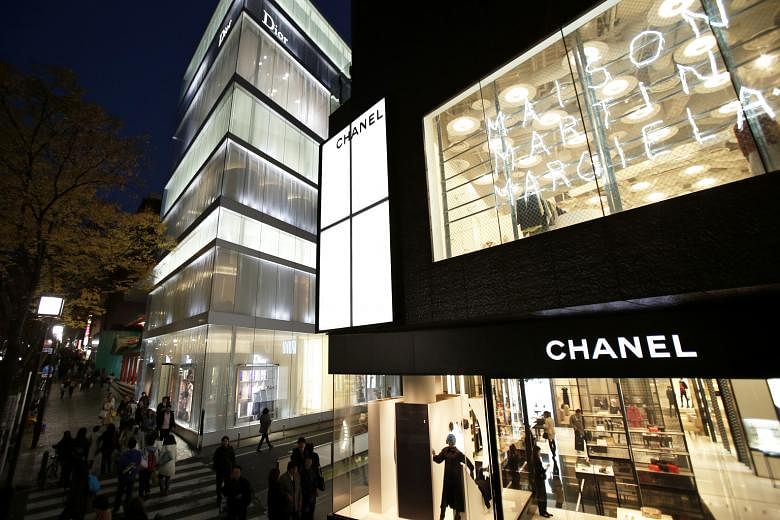It is no secret that high-end fashion labels such as Prada and Cartier have achieved a sort of mythical status in Tokyo.
But here is something you may not know: Visiting their boutiques brings with it an extraordinary reward even if you cannot afford the dizzying prices of the merchandise. They provide, for free, a chance to experience some of the most spectacular buildings in the world.
In the past few years, many of architecture's stars - including Italian Renzo Piano, Dutchman Rem Koolhaas and Japanese Toyo Ito and Tadao Ando - have been hired to design shops for luxury brands and have turned the city into a battleground for a rare, and spectacular, game of architectural one- upmanship.
They have followed one award winner with another, one splashy statement with a splashier one.
While Japanese architecture is known for its cool minimalism, these architects have thrown that out the window, creating sculptural symbols that are difficult to forget.
"The Japanese consumer has an insatiable appetite for the 'new'," said Naomi Pollock, Tokyo correspondent for Architectural Record and author of Made In Japan: 100 New Products (Merrell). "As a result, fashion brands hire architects to create novel, eye-popping boutiques that will lure shoppers."
• Omotesando, East: Prada, Marc Jacobs, Comme des Garcons, Bathing Ape, Cartier and Chloe
The best neighbourhood for this type of "architectural shopping", as I like to call it, is Omotesando, a leafy zone west of the city centre, just outside the blurred neon craziness of Shibuya.
Focused along its main spine, Omotesando (sometimes called the Champs-Elysees of Tokyo), it has long been a home to fashion boutiques and fine architecture.
The level of boutiques and architecture was elevated about a decade ago, when Pritzker Prize-winning Swiss firm Herzog and de Meuron designed a breathtaking store for Prada on the narrower, more hushed, eastern end of Omotesando.
Prada's facade is made of large, diamond-shaped green glass pieces. The glazing is warped, creating funhouse reflections. From within the building, all that glass creates panoramic views of the neighbourhood, framed by a diagonal patchwork quilt.
The store's interior matches the exterior's energy, with sleek curving walls, sculptural built-in shelves and odd touches such as mammoth suitcases and television screens that seem to be growing out of gigantic extension cords.
• Omotesando, West: Tod's Shoes, Hugo Boss, Christian Dior, Louis Vuitton
Once you head west, to the wider section of Omotesando, the thoroughfare becomes much busier, the sidewalks more crowded with swiftly moving masses.
The first stop is arguably the best of them all - Japanese master Ito's Tod's Shoes. In 2013, he won the Pritzker Prize, the profession's highest honour. His store's fractured, matt concrete and glass structure is inspired by the web of tree branches that line the street.
Inside, the motif continues with diamond-shaped walls that lean and list in varied directions. The interior feels very modern, but still warm and comforting.
Next door to Tod's is a new building for Hugo Boss by Japanese architect Norihiko Dan that resembles the turret of a castle, twisted and thinned into a listing chute. Covered with thin lines of grooved concrete, it appears to dance with Tod's, like Frank Gehry's Fred and Ginger building in Prague.
Head west a couple of blocks and you will run into the Coach store, the work of another Pritzker winner - Koolhaas. He has created a frontage of frosted and clear glass blocks that looks like a fancy white Rubik's cube, with vitrines inside repeating this pattern.
Head just a few more blocks west and you arrive at Christian Dior, designed by yet another Pritzker laureate, Japanese firm Sanaa. The architects have created a tall, narrow light box: Windows are covered by translucent screens that ripple like curtains, so only colourful neon peeks through.
• Ginza: Hermes, De Beers, Mikimoto
Once you have had your fill of Omotesando, head about 15 minutes east on the subway to Tokyo's version of Fifth Avenue: the Ginza neighbourhood.
Ginza is one of several tall neon canyons in the city, but more upscale than, for instance, Shinjuku, the area made famous by the 2003 movie Lost In Translation.
Here, another world-famous architect, Piano, has built a narrow tower for Hermes, clad in nine storeys of silky, bourbon-coloured glass blocks. I do not usually love this material, but in this case, it is a surprisingly striking solution.
Look up and you become entranced - it seems as if you could walk right up the side.
In the interior, the translucent blocks lend the display spaces a warm glow and create a show when lights mysteriously change colour and form behind. The effect is particularly strong on the top-floor gallery, with its extra tall floor-to-ceiling glass.
It is also fun to browse more of the amped-up architecture in this area, including the spectacular LED light shows of Chanel, Max Mara and Matsuya, as well as the etched metal facade of two more Louis Vuitton boutiques.
But not every new boutique is a triumph. Many resemble the cookie-cutter locations you see in retail districts around the world.
Even masters such as Ando have their clunkers. His Omotesando Hills mall shows off his stunning exposed concrete walls, so smooth you feel as if you could eat off them. But in the end, it still feels like a mall.
Many local architects complain that these high-end follies are not serious architecture, but gimmicky flash.
In many cases, they are right. But that is okay.
Form, as any architect will learn, follows function. In this case, it is selling a name and a mystique.
NEW YORK TIMES



